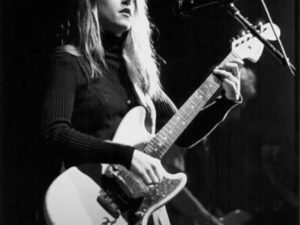By Amit Sharma
Guitar World, November 1, 2021
After 2010’s Funstyle, indie singer-songwriter Liz Phair ended up taking a decade-long break from recorded music. She returns this year with her seventh studio album, Soberish, which – as we find out – was largely inspired by open-tuned explorations on her Yamaha acoustic guitars.
Welcome back! What are the main guitars we’re hearing on Soberish?
“The main electric was my original Fender Duo-Sonic. I think it’s currently being displayed with the Rock and Roll Hall of Fame. It went around the country several times in the Women in Rock exhibit and the Western Rock exhibit. So it’s funny – my guitar has been making the rounds on its own tour.
“You give someone power and what do they do?! My guitar literally took off from me. But we’re building a replica, so right now I have one of the prototypes. I love the jangly feel of them. It’s harder for me to choose a favorite acoustic, because there were quite a few.”
And which models were they?
“I play Yamaha acoustics, and right now it’s usually the AC3M, the LS16, the AC3R or my FG730S. This album was largely written on acoustic, which had its benefits and drawbacks. I can’t explain why, but I really got into alternate tunings. I’d write a song and then play it in different tunings to turn it into something more interesting. So I keep every acoustic in a different tuning, whatever sounds good open on that particular instrument.
“As I’ve gotten older, I’ve always tried to find something that excites me afresh. I’m almost trying to trick myself into thinking the guitar is a new instrument to me. I find standard tuning gives a classic rock feel. You can do stuff with it, sure, but it’s far easier to find interesting things that catch the ear with less-common tunings.”
In There is one of the more musically diverse tracks on the new album. How did you balance the acoustics against electronic elements?
“I actually wrote that song in my sleep. I woke up, grabbed my voice memo and sang the song. I didn’t know what to do with it for a while, so it’s already three years old. I invented the guitar track to go with a song that came through a dream! I was really satisfied with it a cappella, so I wanted to treat it sparsely to give it more air.
“It had this kind of freeness I wanted to keep. It’s not a dance track, but it has similar elements in ways. I don’t think it fits in the indie rock canon, per se, though it does have Casey Rice – the original guitarist from [1993 debut] Exile in Guyville – playing on it!”
Featured image credit: Scott Legato/Getty Images









